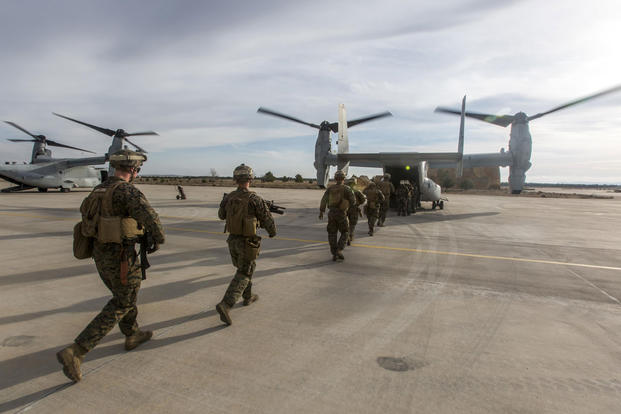Want to win from the water? Add a fourth ship to deploying amphibious ready groups and double the number of strike fighter aircraft aboard.
Those are a few of the key recommendations in a new report from the Center for Strategic and Budgetary Assessments, titled, "Advancing Beyond the Beach: Amphibious Operations in an Era of Precision Weapons."
The 70-page document confronts the new challenges facing Marines and sailors engaged in amphibious warfare, in the form of surface-to-air missiles, anti-ship cruise missiles, and other coastal defense measures frequently lumped under the heading of anti-access and area denial (A2/AD) measures.
Near-peer competitors like China and Russia boast an increasingly complex range of sensors, platforms and weapons designed to keep threats at bay. Currently, authors Bryan Clark and Jesse Sloman write, the Marine Corps, despite its posture as an amphibious force, lacks the ability to safely get close enough to enemy shores to conduct the kind of hostile amphibious assault for which they train.
"Amphibious forces will have difficulty reducing their vulnerability by conducting landings from farther away, because almost all Marine equipment is too heavy to be lifted by shipboard aircraft, and current surface connectors cannot safely conduct a transit long enough to grant amphibious ships the standoff they need," they write.
"Although troops could be moved longer distances by air for small raids, the Marine Expeditionary Unit Air Combat Element is too small to provide enough long-range fires to degrade ground defenses and provide close air support troops conducting the raid," they write.
Despite a trio of new technologies developed by the Marine Corps specifically to help them conduct operational maneuver from the sea -- the MV-22 Osprey, the F-35B Joint Strike Fighter, and the still-developing Amphibious Combat Vehicle -- the employment strategy has weaknesses, according to the authors.
The ACV, optimized for land travel, is slow and cannot conduct landings from over-the-horizon. And the MV-22, while it can fly fast and far, can only carry a single ATV-style vehicle and is not suited to hauling heavy Marine Corps ground equipment, they said.
To get around some of these issues, the authors seize on the new Marine Corps concept of expeditionary advance bases, or EABs -- small forward-based outposts inside contested areas that can be camouflaged from enemy detection while staging troops closer to their objective. These bases could be aboard amphibious ships, such as the new hybrid seabasing platforms entering the fleet, or situated within host nations.
From such posts, they said, Ospreys could conduct amphibious raids, while F-35Bs could engage enemy surface combatants from the air and provide another layer of defense for Navy surface warfare assets, taking advantage of its high-tech detection and targeting technology to keep the fleet safe. The EABs could also host short-range air defense systems to take out enemy fighters, they said.
But the Marines also need to change the way they deploy to face today's challenges, they said. While the F-35B can provide air strikes and close air support, they wrote, its capabilities are constrained by the small number expected to deploy with a conventional MEU's aviation combat element, or ACE.
"The ACE's six F-35Bs would yield four operational aircraft at any given time, which would only be able to support one or two fires missions," they wrote. "A single [Amphibious Ready Group] /MEU, however, may need to support a half-dozen EABs across a region such as Japan's Southwest Islands or the Philippines."
The solution they propose: deploy with more.
Traditionally, ARGs carrying Marines deploy with three amphibious ships: an amphibious transport dock or LPD, a dock landing ship, or LSD, and an amphibious assault ship, an LHA or LHD. If they move to a four-ship configuration, with two L(X)R dock landing ship replacements per ARG, Marines can deploy with 20 F-35B or AV-8B Harrier strike fighter aircraft instead of six aboard the amphibious assault ship, and a more modest complement of four Ospreys instead of 12.
A "fast-assault optimized" deployment package aboard four ships could include 14 Ospreys and 10 strike fighters. This would make amphibs even more like aircraft carriers, and the authors push the proposition even further: the Navy and Marine Corps should eventually develop a class of LHA with catapult-assisted take-off and arrested landing, allowing aircraft without short takeoff and vertical landing capabilities to operate from their decks, they wrote.
Clark and Sloman said the Marine Corps should ask for more America-class amphibious assault ships, optimized for aviation with a larger flight deck and no well deck. Currently, one of these ships, the America, is in service, while another is being built.
Ultimately, these changes would necessitate a larger amphibious fleet, they write, with 11 LHA/LHD amphibious assault ships and and up to 29 L(X)R and LPD amphibs.
Marine officials have long said they want at least 38 amphibious ships, with an ideal goal of 50; however, they are currently constrained to a target of 33 ships. Much about the future remains uncertain, however. While sequestration budget cuts loom, President-elect Donald Trump has said he plans to boost the Navy from its current target of 308 total ships by the early 2020s to an ambitious 350 ships.
-- Hope Hodge Seck can be reached at hope.seck@monster.com. Follow her on Twitter at @HopeSeck.
Related Video:



























